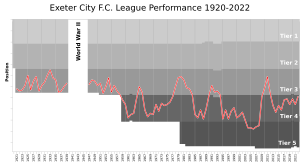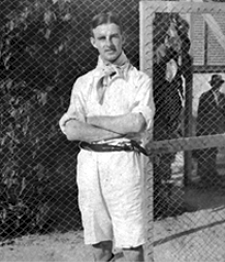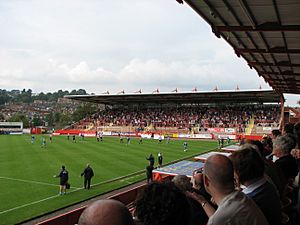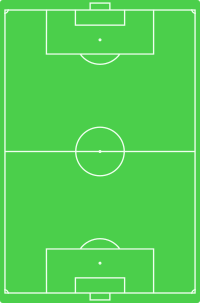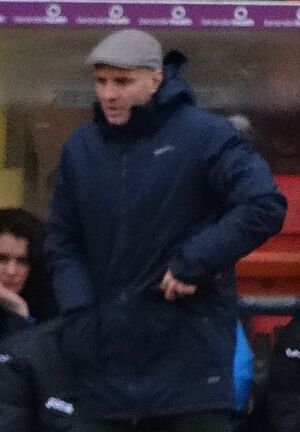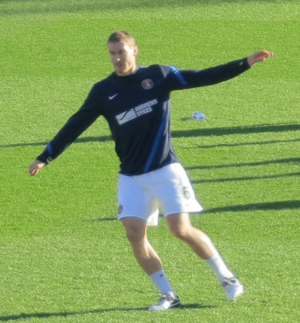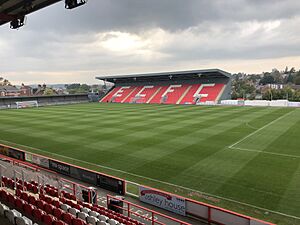History of Exeter City F.C. facts for kids
Exeter City F.C. is an English football club from Exeter, Devon. The club started in 1901 as St. Sidwell's United. They played in the Southern League from 1908. In 1920, they joined The Football League as a founding member of its new Division Three. Exeter City was the first team ever to play the Brazil national team in 1914. This historic match was remembered in a friendly game against Fluminense in 2014.
It took City 60 years to get their first promotion. They finished fourth in Division Four in the 1963–64 season. Since then, the club has often moved between the third and fourth divisions. They spent five years in the Conference (a league outside the Football League) from 2003 to 2008. City has been promoted four more times and relegated five times.
Exeter City has never played in the top two tiers of English football. They have spent more seasons in the third tier than any other club without reaching the second tier. The club's only major title was in the 1989–90 season. Manager Terry Cooper led City to win the Fourth Division title that year.
Contents
- How Exeter City Football Club Started
- Early Years of the Club
- Exeter City's Famous South America Tour (1914)
- Between the World Wars (1918–1940)
- Back in Division Three South (1946–1958)
- Division Four Years (1958–1963 and 1966–1977)
- Time in Division Three (1977–1984)
- The Ivor Doble Era (mid 1980s–2003)
- Relegation and Supporters' Trust Takeover
- The Tisdale Era (2006–2018)
- The Post-Tisdale Era (since 2018)
- Images for kids
How Exeter City Football Club Started
For a long time, people thought that Exeter United and St. Sidwell's United joined together to form Exeter City. This was after a friendly match between them.
However, new information came out in 2014. A book by Aidan Hamilton, Have you ever played Brazil?, shared the real story. Exeter United was the main team in Exeter, formed in 1896. But in 1902, they had trouble finding players. They also couldn't play at St James Park because a building was in the way. On October 25, 1902, Exeter United lost 3–0 to St. Sidwell's United. St. Sidwell's United had formed in 1901 to challenge Exeter United.
After this loss, Exeter United never really recovered. They played very few games after that. By February 1903, they weren't listed in cup competitions. In August 1903, St. Sidwell's United, who were junior champions, started training at St James Park. They were seen as the top club in Exeter. Soon, many former Exeter United players joined St. Sidwell's United. This meant St. Sidwell's United had effectively taken over the other team. On August 31, 1904, St. Sidwell's United decided to change their name to "Exeter City." They felt this was a better name for their strong team.
Early Years of the Club
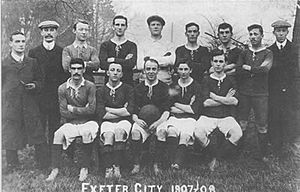
Soon after becoming Exeter City, the club joined the East Devon League. City's first official game was a 2–1 win against the 110th Battery of the Royal Artillery. About 600 fans watched this match. The club quickly moved to the stronger Plymouth and District League. In 1908, City became a professional football club and joined the Southern League.
City didn't win any trophies in their first seven years in the Southern League. But then, something special happened. Both Nottingham Forest and Southampton turned down an offer from the Football Association to tour South America. So, Exeter City was asked to go instead. Research suggests that Tottenham Hotspur also said no to touring Argentina because of the long travel.
Exeter City first wore the green and white colours of St. Sidwell's United. For the 1907–08 season, they changed to green shirts. Then, at the start of the 1910–11 season, they wore green shirts with white sleeves. However, on November 12, 1910, they changed to red and white vertical stripes. This was for a 0–0 home draw against West Ham United. A popular story says City changed from green because they thought it was unlucky after a bad start to the season. Since then, the club has mostly worn red and white stripes.
Exeter City's Famous South America Tour (1914)
In February 1914, The Herald newspaper reported that City agreed to tour South America. They would get £20 for each player, plus first-class travel and all hotel costs paid by the AFA. This was the same deal offered to Tottenham Hotspur. Club chairman Michael McGahey, two directors, and fifteen players set sail in May 1914. Manager Arthur Chadwick was too sick to go. The boat trip to Argentina took three weeks. They stopped in places like Vigo, Madeira, Rio de Janeiro, Santos, and Montevideo. They couldn't land in Recife and Salvador da Bahia due to yellow fever.
Some people thought City only planned to play in Argentina. They believed the games in Brazil were arranged during the tour. But research shows that McGahey had already talked about playing matches in Brazil in May. He met with a Mr Harry Robinson in Rio de Janeiro. They discussed playing games in Rio on their way back.
In Rio, the players visited Paysandu and Fluminense clubs. They had a kickabout at Fluminense. McGahey met with Fluminense officials and Harry Robinson. They suggested City stop in Rio for five days on their return trip and play three matches.
After leaving Rio for Santos, the whole team was briefly held by police for swimming in the sea! McGahey wrote about it, explaining they were just bathing in full swimsuits. A local policeman and a sergeant came. They thought it was a joke, but they were taken to the Chief of Police. Luckily, the complaint was dismissed, and they made it back to their ship in time.
Games in Argentina
In Argentina, City played eight games. Their first game was a 3–0 loss to "Combinado Norte" on June 14, 1914. After training, City beat Combinado Sur 3–0 on June 21. They also beat Racing Club 2–0 on June 24. This game had a strange moment when Racing Club's secretary reportedly threatened the referee with a gun!
There were also problems with the game schedule. But the games were rearranged. City beat Liga Rosarina 3–1 on June 28. They then took an overnight train back to Buenos Aires. City won their fifth game 5–0. On July 9, City beat Liga Argentina 3–0. They then drew 0–0 against an Argentinian team on July 11. The final game in Argentina was a 3–1 win against Liga Argentina on July 12. Many City players were injured or sick for this last game.
Newspapers in Argentina were not very impressed with City's performances. One newspaper called them "the most average team of professionals."
Games in Brazil
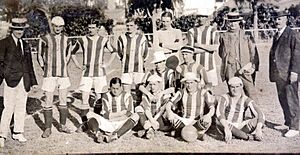
When the idea of playing extra matches in Brazil came up, it was for games with players from Rio de Janeiro. In early July, Brazilian newspapers reported on City's matches in Argentina. On July 2, it was announced that Fluminense and Paysandu had agreed to a contract with McGahey for the games. Exeter City would be the first professional team to play in Brazil. They hoped to play in Sao Paulo too, but there wasn't enough time.
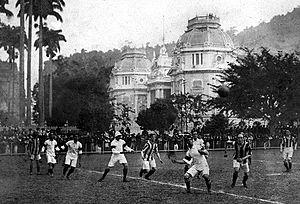
City's ship arrived in Rio de Janeiro on July 17. On July 18, City beat Rio English 3–0. This game was very one-sided. On July 19, it was announced that players from Sao Paulo would come to Rio. Later that day, City beat Rio de Janeiro 5–3. On July 21, City lost 2–0 to Brasileiros, a team of Brazilian players from Rio and Sao Paulo. This game is considered the Brazil national team's first ever match. All three games were played at Fluminense's Estádio das Laranjeiras.
Later, on September 27, seven players from the team that beat City played for Brazil against Argentina. Brazil won that game.
Between the World Wars (1918–1940)
After World War I, City returned to the Southern League for the 1919–20 season. In 1920, The Football League invited the club to be a founding member of the Third Division.
In the 1920s, City struggled with the costs of being a Football League club. They had to sell some of their best players. These included Harold Blackmore and Dick Pym. Pym's £5,000 transfer fee allowed City to buy St James Park. Young player Cliff Bastin was also sold to Arsenal. He later became Arsenal's top goalscorer and played for England. City played in the Third Division South for 18 seasons. This period ended when World War II started in the 1939–40 season. City reached their highest league position during this time, finishing second in 1933. However, only one team could be promoted back then, so they stayed in the division.
First Trip to the Netherlands
On March 15, 1925, City played a friendly match against Ajax in Amsterdam. This was just one day after playing Norwich City in the league. The team traveled by ferry from Harwich to Rotterdam in the morning. Then, in the evening, they beat Ajax 5–1 in front of 15,000 fans. Harry Kirk scored three goals.
FA Cup Run in 1931
In 1931, City had a memorable run in the FA Cup. They beat several teams, including Derby County and Leeds United. They reached the quarter-finals. City drew 1–1 against Sunderland away. They eventually lost 4–2 at home in the replay. This game had the club's largest ever home crowd, with 20,984 fans. This cup run inspired the name for the 1931 Fund. This fund was set up in 2009 to help pay for an extra player for the first team.
Back in Division Three South (1946–1958)
After World War II, City continued to play in the Third Division South. At first, they were a mid-table team. However, in the last seven years before the league changed, City's performance dropped. They finished in the bottom four several times and even last in 1957–58. Because of a league re-organisation in 1958, City found themselves in the new Fourth Division.
Second Trip to the Netherlands
City went back to the Netherlands for a second time in May 1951. They played four friendly matches. They won three games and lost one.
Division Four Years (1958–1963 and 1966–1977)
City started well in the new Division Four. They finished fifth in 1958–59 and ninth in 1959–60. But after manager Frank Broome left, City struggled.
The 1963–64 season was special for City. Manager Jack Edwards led the team to their first ever promotion, finishing 4th. He also kept City in Division Three the next season. But his replacement, Ellis Stuttard, couldn't save City. They finished 22nd in 1965–66 and quickly returned to Division Four.
Back in Division Four, City didn't finish in the top half for their first four seasons. Johnny Newman became player-manager and greatly improved the team.
In the 1973–74 season, City had big financial problems. They had very few fit players due to injuries. The Football League refused to postpone a game against Scunthorpe United. City couldn't field a team, so they didn't show up. Scunthorpe was given the win, and City was fined. This is the only time in Football League history a game was never played because a team couldn't show up. Despite this, City finished 10th that season.
Newman left in December 1976. His replacement, Bobby Saxton, led City to second place and promotion to Division Three.
Time in Division Three (1977–1984)
Saxton helped City stay safe in 1977–78. He left in January 1979. His successor, Brian Godfrey, led City to ninth in 1978–79 and eighth in 1979–80. This was the club's highest league position since the Third Division was no longer split by geography.
City's luck changed after that. They finished lower in the following seasons. Gerry Francis took over as player-manager, but City finished last in 1983–84. This was City's longest time in Division Three since it became one league.
FA Cup Run in 1981
In the 1980–81 season, City had another great FA Cup run. They beat teams like Millwall and Maidstone United. They also beat Leicester City and Newcastle United after drawing away games. City eventually lost 2–0 away to Tottenham Hotspur in the quarter-finals.
The Ivor Doble Era (mid 1980s–2003)
In the early 1980s, local jeweller Ivor Doble became involved with the club. He soon became chairman of Exeter City.
On May 9, 1988, City hired Terry Cooper as manager. After a mid-table finish in his first season, Cooper led City to their only major title in 1989–90. They won the Fourth Division title. City won 20 home league games that season and were unbeaten in all 31 home matches. In 2005, Doble had a copy of the trophy made when the original was taken back by the league sponsors.
After promotion, Cooper led City to 16th in the Third Division. He then left for Birmingham City at the end of the 1990–91 season. Alan Ball became the new manager.
Ball's time saw City barely avoid relegation. In December 1992, part of the floodlights failed during City's home FA Cup game against Swansea City. City fans invaded the pitch, and the match was stopped. City lost the rescheduled match 5–2. At the end of the 1992–93 season, City needed a win to avoid relegation. They were leading, but a controversial penalty was given to their opponents. City supporters invaded the pitch after the game. Despite this, City managed to beat rivals Plymouth Argyle twice that season.
In September 1993, comedian Freddie Starr was interested in buying City, but his interest soon faded. Ball left in January 1994 and was replaced by Terry Cooper again. Despite Cooper's return, City finished 22nd in the 1993–94 season and were relegated.
In August 1994, the club was not allowed to sign new players because of money problems. This meant they only had 18 registered players, many of them very young. The club had to sell St James Park for £650,000 in November 1994. By March 1995, the club was £1.2 million in debt. City almost dropped out of the Football League in 1995. They stayed up because another team's ground didn't meet league rules.
The city council bought the ground back at the end of the 1995–96 season. They leased it back to the club to keep football in the city. City finally got out of their financial difficulties in August 1996.
On April 26, 1997, illusionist Uri Geller tried to use psychic energy to help the club win. He placed crystals by the goalposts. City lost the game 5–1.
City's money situation improved, and they started to rebuild St James Park. In February 2000, the open terraced Big Bank was replaced by a new covered stand. It was named the Cliff Bastin Stand. In 2001, the Cowshed stand was replaced by the Ivor Doble stand, which had seats and executive boxes. The costs of this rebuilding led to new financial problems for City.
In 2002, Ivor Doble wanted to sell the club. Michael Russell and John Lewis became chairman and vice-chairman. Russell wrongly claimed he had enough money to cover the club's debts. Geller and his son were later named co-chairman and co-vice chairman. On June 14, 2002, singer Patti Boulaye, magician David Blaine, and Michael Jackson visited St James Park. Jackson was even invited to be an honorary board member.
The club had a very poor 2002–03 season. Several managers tried to help the club. City was relegated to the Conference. They finished 23rd in the league. They were the first team ever to be relegated to the Conference without finishing last in Division Three.
By the end of Ivor Doble's 20 years as owner, he had invested £1 million in the club.
Relegation and Supporters' Trust Takeover
City's relegation to the Conference National in 2003 brought a big change to the club. On May 14, 2003, John Russell and Mike Lewis faced questions about money management at the club. Uri Geller was one of the people who contacted the authorities. After this, members of the Exeter City Supporters' Trust were appointed as directors. Soon after, Ivor Doble asked the Supporters' Trust to take over running the club.
On September 5, 2003, the Supporters' Trust bought the club from Doble for £20,000. This was almost all the money the Trust had at the time.
In the 2003–04 season, City finished sixth, just missing the play-offs. Manager Eamonn Dolan left in October 2004. Former City player Alex Inglethorpe became the new manager.
In the 2004–05 season, City had a short but exciting FA Cup run. They beat Braintree Town, Grimsby Town, and Doncaster Rovers. On January 8, 2005, Exeter City drew 0–0 against Manchester United at their famous stadium, Old Trafford. City lost 2–0 in the televised replay at St James Park 11 days later. Cristiano Ronaldo and Wayne Rooney scored the goals for Manchester United. The money from these two games, almost £1 million, helped the club pay off almost all its debts. However, City still didn't reach the play-offs that season.
In early 2006, a plan called V10 was introduced. Its goal was simple: to reach League One by 2010. This plan led to changes in the club's leadership. Inglethorpe left to become a youth coach at Tottenham Hotspur.
The Tisdale Era (2006–2018)
On June 26, 2006, former player Paul Tisdale was named the new manager of Exeter City. Tisdale brought in several new players.
In Tisdale's first season, he led City to Wembley Stadium for the first time in the club's history. This was for the play-off final.
In the 2007–08 season, City returned to Wembley for a second year in a row. They beat Torquay United in the play-off semi-final. This time, City won the final against Cambridge United 1–0. This ended their five-year stay outside the Football League.
In just his third season, Tisdale became the most successful manager in Exeter City's history. He led the club to back-to-back promotions in the 2008–09 season. City won promotion on the very last game of the season.
In December 2009, Edward Chorlton became chairman. In January 2010, a new plan was announced. It aimed to keep the club in League One and push for promotion to the Championship. City stayed in League One on the final day of the 2009–10 season.
City reached Brian Godfrey's highest league position by finishing 8th in 2010–11. But they were relegated back to League Two in 2011–12.
The return trip to Brazil in 2014 came at a difficult time for the club. They were not allowed to sign new players because of a loan they took out. However, City paid off the loan and could sign players again.
Despite being expected to be relegated, the 2014–15 season was good for City. They sold a young player, Matt Grimes, for a club record fee of £1.75 million. They finished 10th in the league.
The 2015–16 season saw City miss out on the play-offs again. However, they had some good moments. They beat rivals Plymouth Argyle twice. They also drew 2–2 with Liverpool in the FA Cup third round before losing the replay.
The 2016–17 season was very dramatic. City started poorly, losing five home league games in a row. This included a loss to Plymouth Argyle. With many injuries, the Supporters' Trust decided to end Tisdale's contract. But City's form improved greatly. They won seven league games in a row. They also broke their record for away wins in a single season. They secured a play-off spot. In a thrilling play-off semi-final, City won 6–5 on aggregate against Carlisle United. They reached the final but lost 2–1 against Blackpool.
In the 2017-18 season, they lost in the play-off final again, this time to Coventry.
Tisdale left the club on June 1, 2018, after 12 years in charge.
Trip to Norway
Before the 2011–12 season, City went on a five-day pre-season trip to Norway. They played three matches in three days. They won two games and drew one.
Return to Brazil
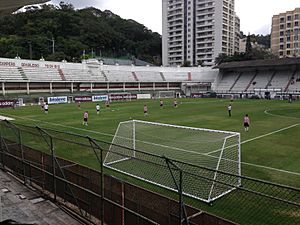
On July 26, 2013, it was announced that City would play a friendly match against Fluminense in July 2014. This was to celebrate 100 years since the Brazil national team's first game. Club captain Scot Bennett said it would be a "dream come true" to play in Brazil after the World Cup.
In Brazil, City played three friendly matches. They drew 0–0 against Fluminense under-23s. They won 2–1 against Tupi and 3–1 against Rio Cricket e Associação Atlética. After the Fluminense game, the City team and fans were invited to watch Fluminense's first team play.
However, the trip to Brazil affected City's squad. A sickness bug meant manager Tisdale had to be on the bench for the first game of the season.
The Post-Tisdale Era (since 2018)
Former captain Matt Taylor became the new manager on June 1, 2018. This was announced after Paul Tisdale's departure.
Many staff members followed Tisdale to another club. So, Taylor had to build a new team of coaches. He also signed new players like Aaron Martin and Jonathan Forte. City won their first league match under Matt Taylor, beating Carlisle United 3–1. City started the season well. But they missed out on the play-offs on the final day of the season.
Despite missing the play-offs, the season was important for City. A £3.5 million redevelopment of the stadium was finished in October 2018. The new Adam Stansfield stand was opened for a game on October 27.
Taylor had to rebuild his coaching staff again before the 2019–20 season. He also changed the playing squad. Eight new players joined, and nine left. Jonathan Forte had to retire due to a knee injury.
The club was in fourth place in the league when matches were stopped due to the COVID-19 pandemic.
Images for kids


